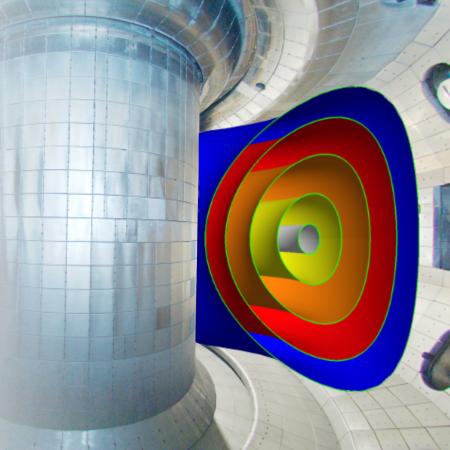
An illustration of negative triangularity (or reversed D) plasma inside the DIII-D vacuum vessel, showing the change in temperature from the hot core (yellow) to the cooler edge (blue).
Illustration courtesy of Max Austin (University of Texas as Austin)
PSFC research scientist extends exploration of reversed D-shaped plasmas in tokamaks to consider the fusion furnace environment.
October 22, 2021
Trying to duplicate the power of the sun for energy production on earth has challenged fusion researchers for decades. One path to endless carbon-free energy has focused on heating and confining plasma fuel in tokamaks, which use magnetic fields to keep the hot plasma circulating within a doughnut-shaped vacuum chamber and away from the walls. Fusion researchers have typically favored contouring these tokamak plasmas into a triangular or D shape, with the curvature of the D stretching away from the center of the doughnut, which allows plasma to withstand the intense pressures inside the device better than a circular shape. Led by research scientists Alessandro Marinoni (MIT Plasma Science and Fusion Center - PSFC) and Max Austin (University of Texas at Austin), researchers at the DIII-D National Fusion Facility reported in 2019 promising evidence that reversing the conventional shape of the plasma in the tokamak chamber can create a more stable environment for fusion to occur, even under high pressure. In a paper recently published in Nuclear Fusion Marinoni and Austin continue to examine this innovative plasma shape, dubbed “negative triangularity,” extending previous research to configurations more compatible with the plasma environment of a reactor.
What question are you addressing in this paper?
The leading candidate for operation in future tokamak reactors is the “high-confinement” (or “H-mode”) regime, which achieves the levels of plasma pressure necessary to self-sustain fusion reactions by quenching turbulence in a narrow region near the plasma periphery, referred to as an “edge barrier.”
Sustaining the edge barrier, however, requires a minimum level of heat flux crossing the plasma periphery that, in future reactors, will be higher than present materials can withstand without damage. Consequently, while the edge barrier allows the plasma core to produce fusion reactions, it also makes it hard for the chamber wall to withstand the heat exiting the plasma core.
This research aims at finding a configuration that can sustain large enough pressures without having to rely on an edge barrier.
What were your findings?
Plasma discharges on the DIII-D tokamak with negative triangularity shape (the reversed D) exhibit lower turbulence than their positive D counterparts, allowing the plasma to become sufficiently hot and dense even without the help of the edge barrier. Furthermore, this peculiar shape inhibits the formation of the edge barrier despite the auxiliary power far exceeding the threshold at which the H-mode is triggered in standard configurations.
The absence of an edge barrier is beneficial in several ways. For example, it reduces the intensity of heat that reaches the wall; it prevents a class of wall-harming events known as ELMs that are triggered by the barrier; it also lowers the content of impurities that have entered the plasma from the vacuum chamber lining. Instead, reactors operating in H-mode will likely require dedicated control systems to handle such issues.
How does it build on previous work?
Earlier research on the TCV tokamak at École Polytechnique Fédérale de Lausanne and DIII-D achieved high confinement operation without edge barriers in negative triangularity configurations. However, due to technical constraints, those experiments used a plasma limiter, a small piece of metal that protects the wall from the plasma. Since limiters are incompatible with the plasma environment of a reactor, this work extends previous results to a negative triangularity configuration using a divertor, a device that allows for removal from the plasma of fusion products and impurities while the reactors is still operating.
Why is it important?
The achievement of diverted plasma discharges characterized by H-mode levels of confinement despite the absence of an edge barrier is a major step in assessing whether negative triangularity is a viable scenario for operation in future fusion reactors.
The worldwide fusion community has historically considered the H-mode regime as necessary to achieve the pressure levels required to sustain the thermo-nuclear reactions, while intense research in the past decades has focused on solving difficulties associated with the edge barrier. This work challenges the “H-mode, a must” paradigm by demonstrating that edge barriers might not be required in future reactors, thereby simplifying the associated control tools that will be needed.
Topics: Magnetic fusion energy, Plasma material interactions, Plasma turbulence, Tokamak & stellarator collaborations